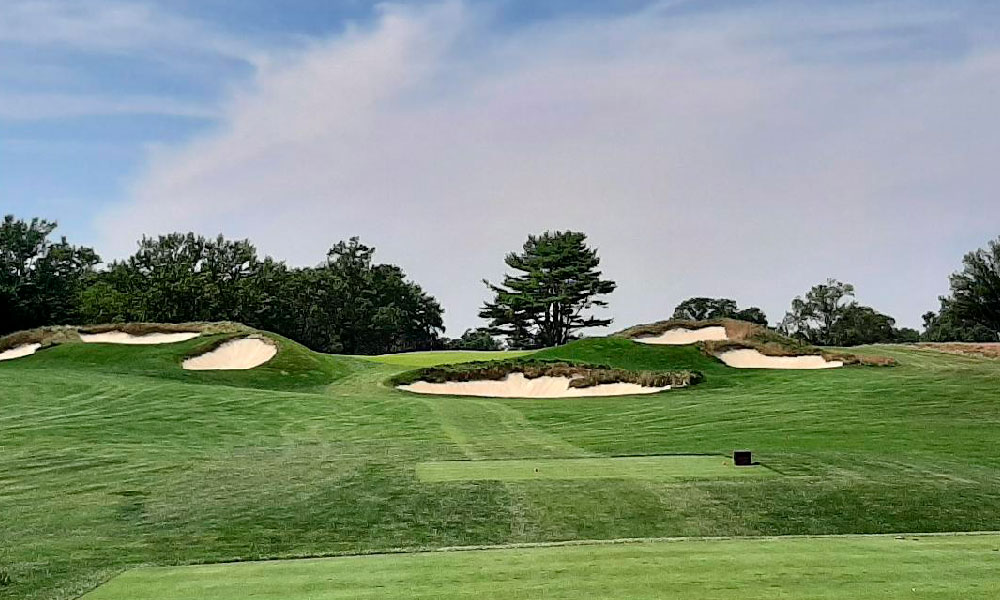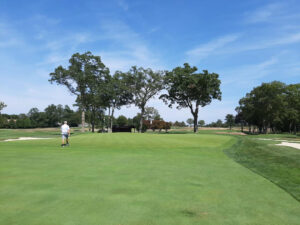If you were to magically materialize somewhere inside the grounds of New Jersey’s Hollywood Golf Club, you’d have no idea what year it was or where on Planet Earth you were. And that’s the greatest compliment you can pay a golf course restoration.
Hollywood has always been one of the most venerable Golden Age golf clubs in America, with a sterling architectural pedigree and a membership fervently committed to protecting and promoting the legacy of their most celebrated and influential designer, Walter Travis, “The Grand Old Man” as he’s called. Now, with a sparkling restoration spearheaded by Brian Schneider, senior design associate of Tom Doak’s Renaissance Golf Design team, Hollywood once again blazes brightly as a crown jewel in the Travis diadem.
Walter Travis was a giant both as a player and as a golf architect. Born and educated in Australia, he came to America in 1885 and quickly skyrocketed to golf immortality. He won the U.S. Amateur in 1900, 1901, and 1903 (at Garden City Golf Club, Atlantic City G.C., and Nassau C.C. respectively.) He also became the first American to win the British Amateur, at Royal St. George’s in 1904. Perhaps only Ben Crenshaw can claim as much success as both a player and an architect.
Travis was also an influential writer, penning columns for The American Golfer, a bedrock foundational sports periodical of the age. It was his fervent belief that courses needed to be made more difficult for professional players and experts, but easier for average golfers, and his intelligent and entertaining articles were persuasively written. Several golf historians believe they likely attracted the attention of several Golden Age golf courses, including both Garden City Golf Club and Hollywood.
I name those two courses because in both cases he inherited someone else’s routing and his greatest contributions were the bunkering and the green contours. The difference between the two projects is that at Garden City, Travis – rightfully in this author’s opinion – shares design credit with another immortal, Devereux Emmet. There is as much of Devereux Emmet’s architectural philosophy to study at Garden City as there is Walter Travis’s.
At Hollywood, however, his contributions were far more significant. When he arrived in 1915, Travis kept the bulk of a 1913 Isaac Mackie routing – leaving the playing corridors mostly intact – but completely redesigned the bunkers, green complexes, and strategic playing angles so that they were totally new and inimitably his.
“Travis is likely best known for his brilliant, intricately-contoured green complexes, and Hollywood is certainly one of his finest sets,” explained Brian Schneider, who oversaw the restoration back to Travis’s 1918 original design. “Travis was well into his design career by the time he got to Hollywood, and the course is a bit of an anomaly among his work, as the bunkering is much wilder and more extensive than anything he did anywhere else. I attribute that to his involvement in the development of Pine Valley, where he’d spent a fair bit of time leading up to Hollywood.”
[Author’s Note: We’ll be writing about the formative years of Pine Valley later this year, exploring the roles of Travis and many others in its creation.]
Sadly, like so many Golden Age courses, during the intervening decades between then and now, numerous other architects did redesign work. Moreover, trees began to crowd the fairways, restricting airspace and further limiting playing options.
“A golf course is a living breathing thing, evolving over time. Also, we had three architects of note – Dick Wilson, Geoffrey Cornish, and Rees Jones – all make changes to the course over the years. But, happily, no one touched our greens except for the 17th,” explained Greens Chairman and three-time club champion Rob Wolf, who began as a caddie at the club when he was a teenager. He can recall over five decades of club events.
“The bones of the course are Travis’s, and Hollywood likely has the best-preserved, most un-altered Travis greens anywhere in the world. His legacy is worthy of celebrating and furthering, and so, like many great Golden Age courses, we wanted to go back to what we once had,” Wolf surmised. “The course has been here for 100 years, and we wanted it to look 100 years old. The culture and ideology of Tom Doak, Brian Schneider, and Renaissance Golf matched perfectly with what we wanted to accomplish: We wanted to recreate the classic, and that’s exactly what they did,” he concluded fondly.
The project has been a runaway success, and many in golf design circles are lining up to see what may arguably be the best restoration of the year. Over 1,200 non-strategic trees were removed, including 400 on the iconic 12th hole alone, nicknamed the “Heinz 57 Hole” for the urban legend that says 57 bunkers pepper its fairway and green complex.
As an aside, as usual, rumor loves to make the hearer’s flesh creep. There are really only 40-odd bunkers…maybe 45, nobody’s really sure.
“People tend to lose count, or track or both,” laughed Wolf.
All 40 or 45 of those bunkers were rebuilt, along with the rest of the 175 on the course. Using a 1940 aerial as an overlay, Doak, Schneider, and head superintendent Michael Broome put the bunkers back where Travis had them originally with the genius result that the hazards were now out of play for the golfer who shoots 100, but dangerously in play for the golfer who shoots 72.
That’s what Travis strove for as a designer, and it may have been why he was hired in the first place.
“The overlay was a great help, but so were the notes of Frank Barrett, the greens chair during Travis’s design work. Barrett stayed greens chair well into the 1930s, and he wrote a description that had important details,” Schneider noted. “We had excellent historical materials and also high-quality ground-level pictures of roughly half of the holes. Getting the aesthetic details right on the other half was probably our biggest challenge during the work, but also the most satisfying to get right.”
And get everything right, they did. Tree removal increased airflow around the course, promoting healthier turf everywhere. Removing the first cut of rough created wider fairways and restored the multiple playing options Travis envisioned. And fairways blend perfectly seamlessly into the greens, a masterstroke of conditioning from head superintendent Michael Broome, who came to Hollywood from nearby Saucon Valley. [Author’s Note: Another sterling Golden Age club that we will feature in our next issue!]
Best of all, everything was accomplished in a minimalist fashion. All this results in outstanding fast, firm conditions, which make Travis’s bold features such as severe false fronts come to life with an electrifying ferocity. Greens are pulled back all the way to their edges, but like many Donald Ross courses, such as Seminole, at Hollywood, the edges are rolled off sharply, so the greens are really only 2/3 of the size they appear. It’s one of Travis’s most successful optical illusions and is a brilliant example of why you don’t need gargantuan length to defend par, you need more interesting green contours and complexes.
“There is a ton of variety among Hollywood’s greens, including a few standouts like the 4th, 6th and 9th that you won’t find anywhere else,” Schneider stated excitedly. “At the fourth, the gorgeous skyline green is guarded by 10-12 foot high mounds surrounding it. [Author’s Note: like monoliths!] The par-4 sixth green features not one but two bowls, separated by a spine and protected by a tricky false front. and the funky back left bowl plays havoc with your depth perception because it’s so much lower than the rest of the green. You can t figure out why the pin is two feet shorter.”
Additionally, Travis’s bunkers at Hollywood are turned perpendicular to the line of play and are built above grade, meaning the golfer must play over and around them.
“The abundance of bunkering leads to a lot of conscious decision making, and more than a few alternate routes from tee to green,” Schneider noted approvingly. Besides the “Heinz 45” 12th hole, two excellent examples include the Principal’s Nose bunker in the middle of the 13th fairway, (always a useful arrow in the quiver of a Golden Age architect), and the Volcano bunker guarding the 16th fairway: both aesthetically amusing and strategic, because the closer you play towards it, the better the angle for your next shot.
While the course features only three par-3s and three par-5s, none of the holes seem repetitive or milquetoast. Just one block from the ocean, with the fragrant salt tang of the Atlantic invigorating you as you play, around at Hollywood is a high adventure all day on golf terrain as wild and timeless as anything you’d find in the UK. The greatest restorations evoke timelessness, and through Renaissance Design’s work, Travis himself has returned to Hollywood, both literally and metaphorically.
“The club asked us if they should add Tom Doak’s name to the scorecard as a design credit, along with the names of all the other designers who did work here,” Schneider noted. “We told them ‘No…take off everyone’s name but Travis’s.’”
And that’s exactly what they did.
“Our expectations were exceeded on all fronts,” Wolf beamed energetically. “They brought back the best of our architectural heritage. We couldn’t be happier.”
Neither could the Grand Old Man himself.
When not reporting live from major sports championships or researching golf courses for design, value and excitement, multiple award-winning sportswriter Jay Flemma is an entertainment, Internet, trademark, and banking lawyer from New York. His clients have been nominated for Grammy and Emmy awards, won a Sundance Film Festival Best Director award, performed on stage and screen, and designed pop art for museums and collectors. Twitter @JayGolfUSA


















